Frankenstein: Analyzing Universal Themes in Mary Shelley's Novel
VerifiedAdded on 2022/08/20
|8
|1769
|11
Essay
AI Summary
This essay provides a comprehensive analysis of Mary Shelley's Frankenstein, examining its enduring relevance and exploration of universal themes. The essay delves into the key themes of irresponsible creativity, the relationship between creator and creature, and the conflict between man and nature, highlighting their social and psychological implications. It argues that despite the novel's fantastic elements, it effectively captures human emotions and societal concerns that remain pertinent today, drawing parallels to contemporary issues such as social media's impact and psychological disorders. The analysis draws upon biographical elements, critical perspectives, and the novel's narrative structure to support its hypothesis, concluding that Frankenstein's timeless appeal lies in its ability to reflect and critique the human condition across different eras. This essay aims to demonstrate the novel's continued significance in literature, psychology and philosophy.

Paraphrase This Document
Need a fresh take? Get an instant paraphrase of this document with our AI Paraphraser
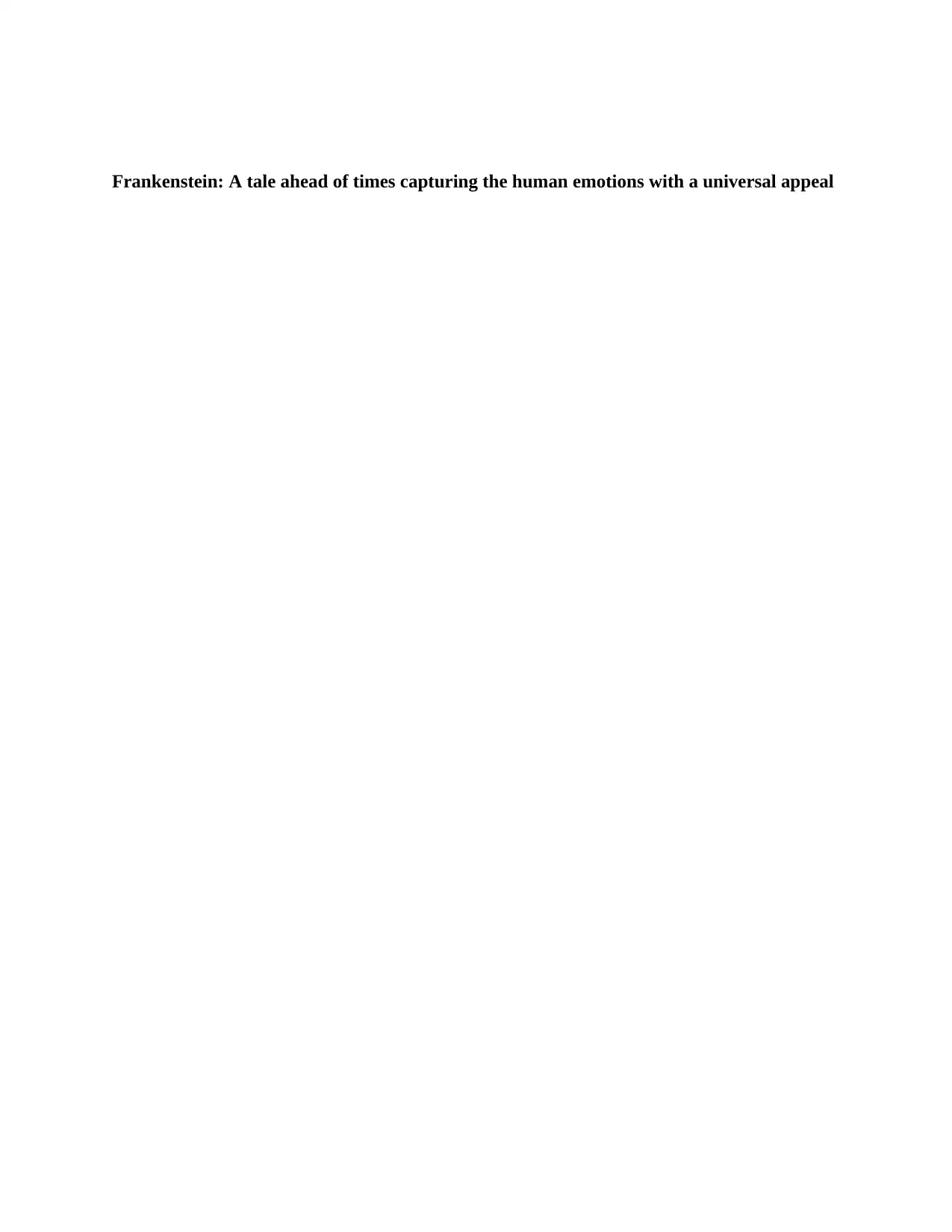
Frankenstein: A tale ahead of times capturing the human emotions with a universal appeal
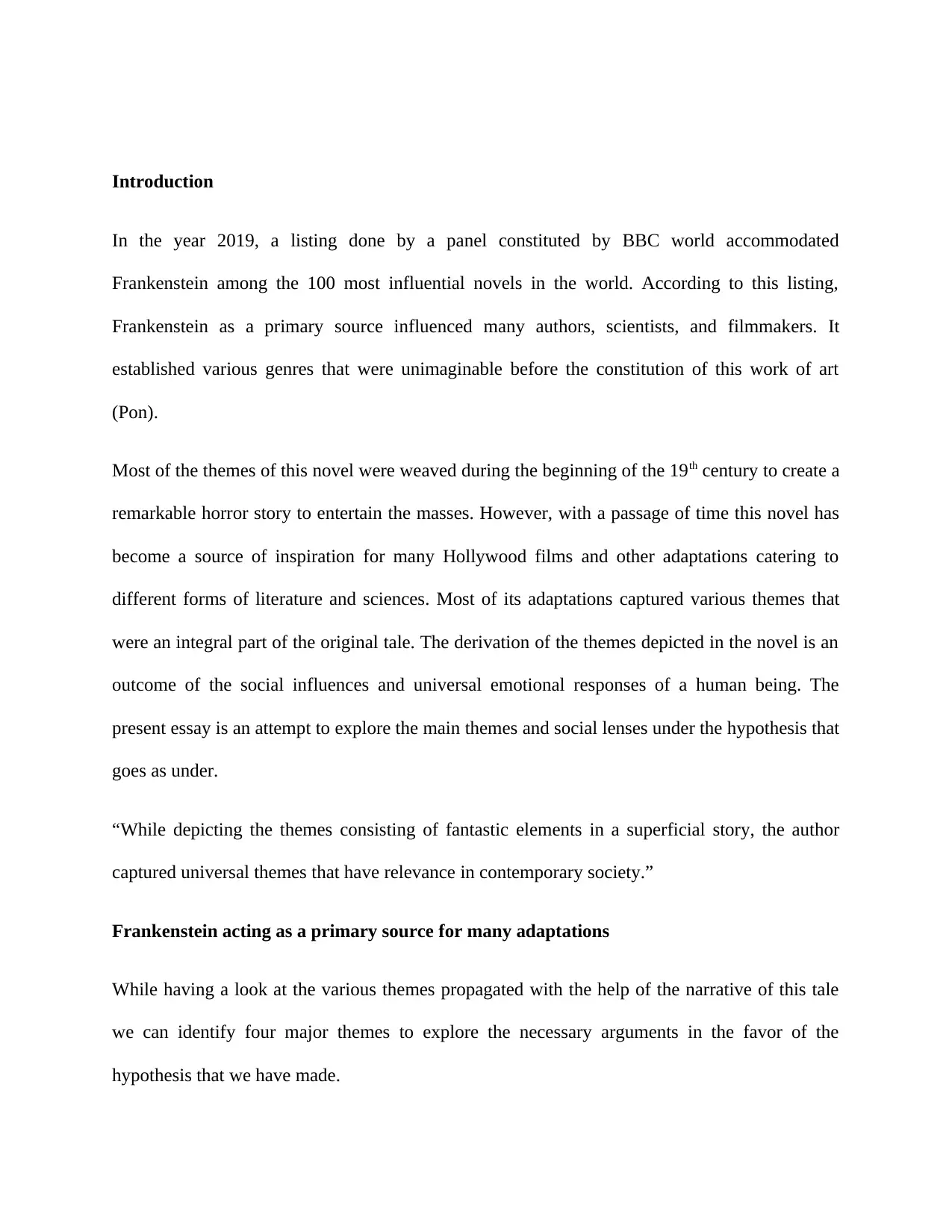
Introduction
In the year 2019, a listing done by a panel constituted by BBC world accommodated
Frankenstein among the 100 most influential novels in the world. According to this listing,
Frankenstein as a primary source influenced many authors, scientists, and filmmakers. It
established various genres that were unimaginable before the constitution of this work of art
(Pon).
Most of the themes of this novel were weaved during the beginning of the 19th century to create a
remarkable horror story to entertain the masses. However, with a passage of time this novel has
become a source of inspiration for many Hollywood films and other adaptations catering to
different forms of literature and sciences. Most of its adaptations captured various themes that
were an integral part of the original tale. The derivation of the themes depicted in the novel is an
outcome of the social influences and universal emotional responses of a human being. The
present essay is an attempt to explore the main themes and social lenses under the hypothesis that
goes as under.
“While depicting the themes consisting of fantastic elements in a superficial story, the author
captured universal themes that have relevance in contemporary society.”
Frankenstein acting as a primary source for many adaptations
While having a look at the various themes propagated with the help of the narrative of this tale
we can identify four major themes to explore the necessary arguments in the favor of the
hypothesis that we have made.
In the year 2019, a listing done by a panel constituted by BBC world accommodated
Frankenstein among the 100 most influential novels in the world. According to this listing,
Frankenstein as a primary source influenced many authors, scientists, and filmmakers. It
established various genres that were unimaginable before the constitution of this work of art
(Pon).
Most of the themes of this novel were weaved during the beginning of the 19th century to create a
remarkable horror story to entertain the masses. However, with a passage of time this novel has
become a source of inspiration for many Hollywood films and other adaptations catering to
different forms of literature and sciences. Most of its adaptations captured various themes that
were an integral part of the original tale. The derivation of the themes depicted in the novel is an
outcome of the social influences and universal emotional responses of a human being. The
present essay is an attempt to explore the main themes and social lenses under the hypothesis that
goes as under.
“While depicting the themes consisting of fantastic elements in a superficial story, the author
captured universal themes that have relevance in contemporary society.”
Frankenstein acting as a primary source for many adaptations
While having a look at the various themes propagated with the help of the narrative of this tale
we can identify four major themes to explore the necessary arguments in the favor of the
hypothesis that we have made.
⊘ This is a preview!⊘
Do you want full access?
Subscribe today to unlock all pages.

Trusted by 1+ million students worldwide

The theme of “irresponsible creativity” is one such theme. This is the primary theme that
attracted the fancy of filmmakers and sci-fi novel writers. When we have a look at the
development phase of the Frankenstein with the help of the study of biographical elements
attached to it, an anecdote draws our attention, this anecdote that narrates about her quest to
search for some elements of horror in a story. While donning the hat of a critic, searching for
necessary elements to entertain the contemporary society in the 21st century, any critique may jot
down the qualities of “love”, “friendship,” and “tranquility” as the primary inspiration for a
writer. This opinion becomes even more important because in the 21st century we are living a life
where our brains are stimulated with multiple influences. The life of journey of Victor
Frankenstein also raises a valid question, the evidence presented in the story gives us an account
of the paradox of the human nature, and Victor created the creature because he was suffering
from grief and experimentation with a creature was a diversion for him. Victor was seeking for
friendship and tranquility; however, it was irresponsible creativity that created a monster for him
(Lepore).
The tale of Frankenstein was developed at the beginning of the 19th century; however, this
concept of creating a monster can be equated with the creation of the “social media” in the 21st
century. Social media was invented to bring in connectivity and happiness in the life of the
individuals, however, the same social media has become a monster in the life of the people and
forcing them towards isolation and severe psychological diseases like depression and others.
This comparison of social media and the theme of the tale implies towards the first argument that
says “ The theme depicting the concept of “irresponsible creativity” can be utilized to explain the
role of the technology in a world where consumerism has become the order of the day and
attracted the fancy of filmmakers and sci-fi novel writers. When we have a look at the
development phase of the Frankenstein with the help of the study of biographical elements
attached to it, an anecdote draws our attention, this anecdote that narrates about her quest to
search for some elements of horror in a story. While donning the hat of a critic, searching for
necessary elements to entertain the contemporary society in the 21st century, any critique may jot
down the qualities of “love”, “friendship,” and “tranquility” as the primary inspiration for a
writer. This opinion becomes even more important because in the 21st century we are living a life
where our brains are stimulated with multiple influences. The life of journey of Victor
Frankenstein also raises a valid question, the evidence presented in the story gives us an account
of the paradox of the human nature, and Victor created the creature because he was suffering
from grief and experimentation with a creature was a diversion for him. Victor was seeking for
friendship and tranquility; however, it was irresponsible creativity that created a monster for him
(Lepore).
The tale of Frankenstein was developed at the beginning of the 19th century; however, this
concept of creating a monster can be equated with the creation of the “social media” in the 21st
century. Social media was invented to bring in connectivity and happiness in the life of the
individuals, however, the same social media has become a monster in the life of the people and
forcing them towards isolation and severe psychological diseases like depression and others.
This comparison of social media and the theme of the tale implies towards the first argument that
says “ The theme depicting the concept of “irresponsible creativity” can be utilized to explain the
role of the technology in a world where consumerism has become the order of the day and
Paraphrase This Document
Need a fresh take? Get an instant paraphrase of this document with our AI Paraphraser
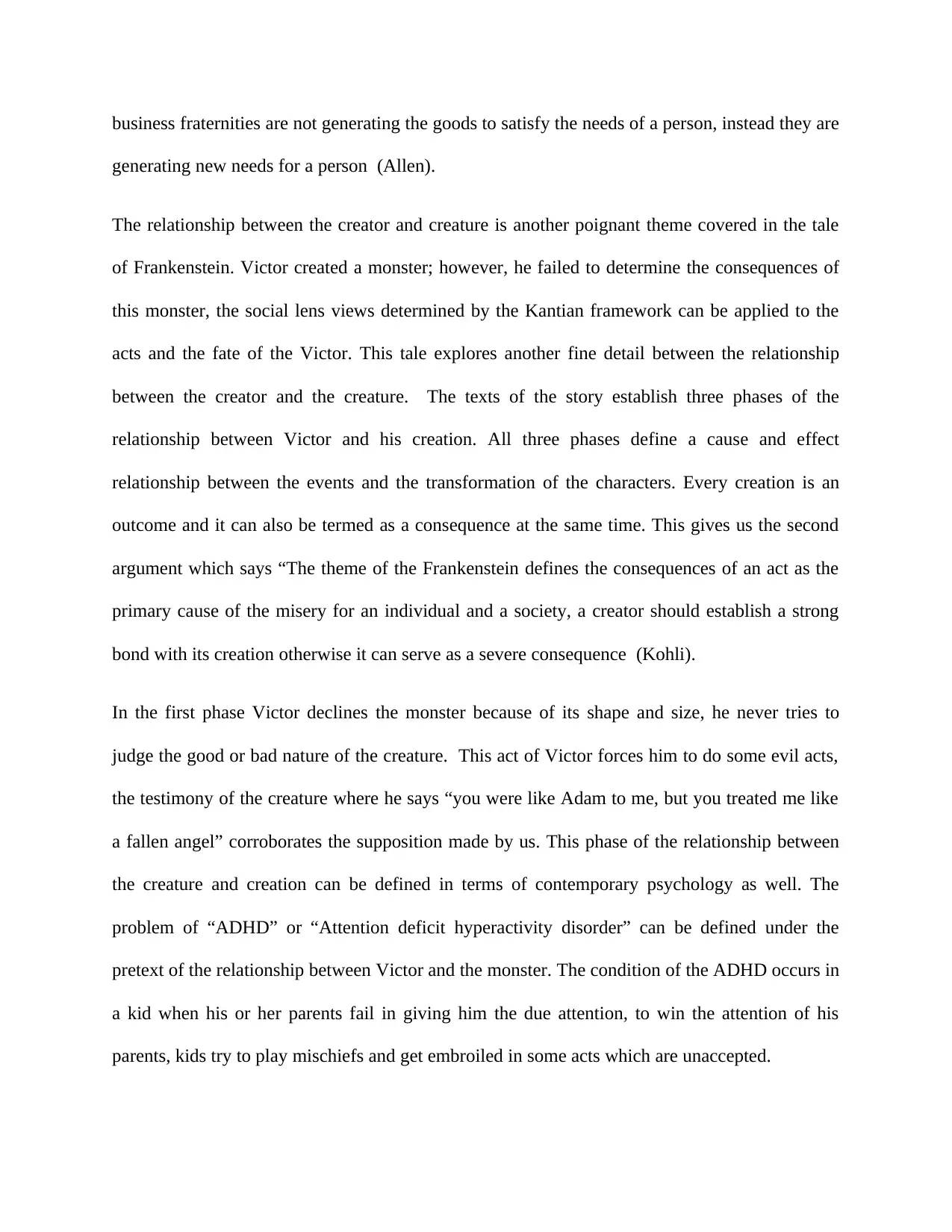
business fraternities are not generating the goods to satisfy the needs of a person, instead they are
generating new needs for a person (Allen).
The relationship between the creator and creature is another poignant theme covered in the tale
of Frankenstein. Victor created a monster; however, he failed to determine the consequences of
this monster, the social lens views determined by the Kantian framework can be applied to the
acts and the fate of the Victor. This tale explores another fine detail between the relationship
between the creator and the creature. The texts of the story establish three phases of the
relationship between Victor and his creation. All three phases define a cause and effect
relationship between the events and the transformation of the characters. Every creation is an
outcome and it can also be termed as a consequence at the same time. This gives us the second
argument which says “The theme of the Frankenstein defines the consequences of an act as the
primary cause of the misery for an individual and a society, a creator should establish a strong
bond with its creation otherwise it can serve as a severe consequence (Kohli).
In the first phase Victor declines the monster because of its shape and size, he never tries to
judge the good or bad nature of the creature. This act of Victor forces him to do some evil acts,
the testimony of the creature where he says “you were like Adam to me, but you treated me like
a fallen angel” corroborates the supposition made by us. This phase of the relationship between
the creature and creation can be defined in terms of contemporary psychology as well. The
problem of “ADHD” or “Attention deficit hyperactivity disorder” can be defined under the
pretext of the relationship between Victor and the monster. The condition of the ADHD occurs in
a kid when his or her parents fail in giving him the due attention, to win the attention of his
parents, kids try to play mischiefs and get embroiled in some acts which are unaccepted.
generating new needs for a person (Allen).
The relationship between the creator and creature is another poignant theme covered in the tale
of Frankenstein. Victor created a monster; however, he failed to determine the consequences of
this monster, the social lens views determined by the Kantian framework can be applied to the
acts and the fate of the Victor. This tale explores another fine detail between the relationship
between the creator and the creature. The texts of the story establish three phases of the
relationship between Victor and his creation. All three phases define a cause and effect
relationship between the events and the transformation of the characters. Every creation is an
outcome and it can also be termed as a consequence at the same time. This gives us the second
argument which says “The theme of the Frankenstein defines the consequences of an act as the
primary cause of the misery for an individual and a society, a creator should establish a strong
bond with its creation otherwise it can serve as a severe consequence (Kohli).
In the first phase Victor declines the monster because of its shape and size, he never tries to
judge the good or bad nature of the creature. This act of Victor forces him to do some evil acts,
the testimony of the creature where he says “you were like Adam to me, but you treated me like
a fallen angel” corroborates the supposition made by us. This phase of the relationship between
the creature and creation can be defined in terms of contemporary psychology as well. The
problem of “ADHD” or “Attention deficit hyperactivity disorder” can be defined under the
pretext of the relationship between Victor and the monster. The condition of the ADHD occurs in
a kid when his or her parents fail in giving him the due attention, to win the attention of his
parents, kids try to play mischiefs and get embroiled in some acts which are unaccepted.
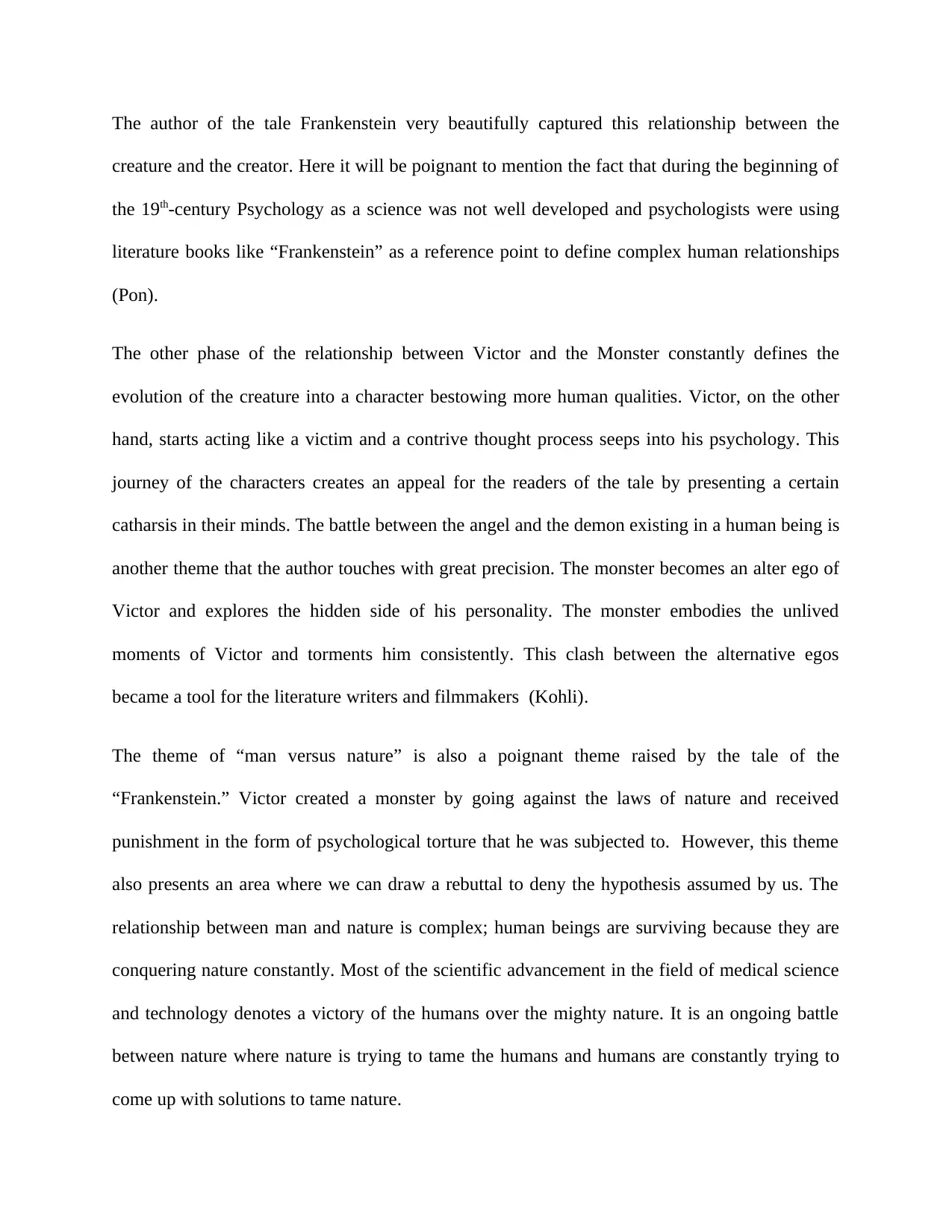
The author of the tale Frankenstein very beautifully captured this relationship between the
creature and the creator. Here it will be poignant to mention the fact that during the beginning of
the 19th-century Psychology as a science was not well developed and psychologists were using
literature books like “Frankenstein” as a reference point to define complex human relationships
(Pon).
The other phase of the relationship between Victor and the Monster constantly defines the
evolution of the creature into a character bestowing more human qualities. Victor, on the other
hand, starts acting like a victim and a contrive thought process seeps into his psychology. This
journey of the characters creates an appeal for the readers of the tale by presenting a certain
catharsis in their minds. The battle between the angel and the demon existing in a human being is
another theme that the author touches with great precision. The monster becomes an alter ego of
Victor and explores the hidden side of his personality. The monster embodies the unlived
moments of Victor and torments him consistently. This clash between the alternative egos
became a tool for the literature writers and filmmakers (Kohli).
The theme of “man versus nature” is also a poignant theme raised by the tale of the
“Frankenstein.” Victor created a monster by going against the laws of nature and received
punishment in the form of psychological torture that he was subjected to. However, this theme
also presents an area where we can draw a rebuttal to deny the hypothesis assumed by us. The
relationship between man and nature is complex; human beings are surviving because they are
conquering nature constantly. Most of the scientific advancement in the field of medical science
and technology denotes a victory of the humans over the mighty nature. It is an ongoing battle
between nature where nature is trying to tame the humans and humans are constantly trying to
come up with solutions to tame nature.
creature and the creator. Here it will be poignant to mention the fact that during the beginning of
the 19th-century Psychology as a science was not well developed and psychologists were using
literature books like “Frankenstein” as a reference point to define complex human relationships
(Pon).
The other phase of the relationship between Victor and the Monster constantly defines the
evolution of the creature into a character bestowing more human qualities. Victor, on the other
hand, starts acting like a victim and a contrive thought process seeps into his psychology. This
journey of the characters creates an appeal for the readers of the tale by presenting a certain
catharsis in their minds. The battle between the angel and the demon existing in a human being is
another theme that the author touches with great precision. The monster becomes an alter ego of
Victor and explores the hidden side of his personality. The monster embodies the unlived
moments of Victor and torments him consistently. This clash between the alternative egos
became a tool for the literature writers and filmmakers (Kohli).
The theme of “man versus nature” is also a poignant theme raised by the tale of the
“Frankenstein.” Victor created a monster by going against the laws of nature and received
punishment in the form of psychological torture that he was subjected to. However, this theme
also presents an area where we can draw a rebuttal to deny the hypothesis assumed by us. The
relationship between man and nature is complex; human beings are surviving because they are
conquering nature constantly. Most of the scientific advancement in the field of medical science
and technology denotes a victory of the humans over the mighty nature. It is an ongoing battle
between nature where nature is trying to tame the humans and humans are constantly trying to
come up with solutions to tame nature.
⊘ This is a preview!⊘
Do you want full access?
Subscribe today to unlock all pages.

Trusted by 1+ million students worldwide
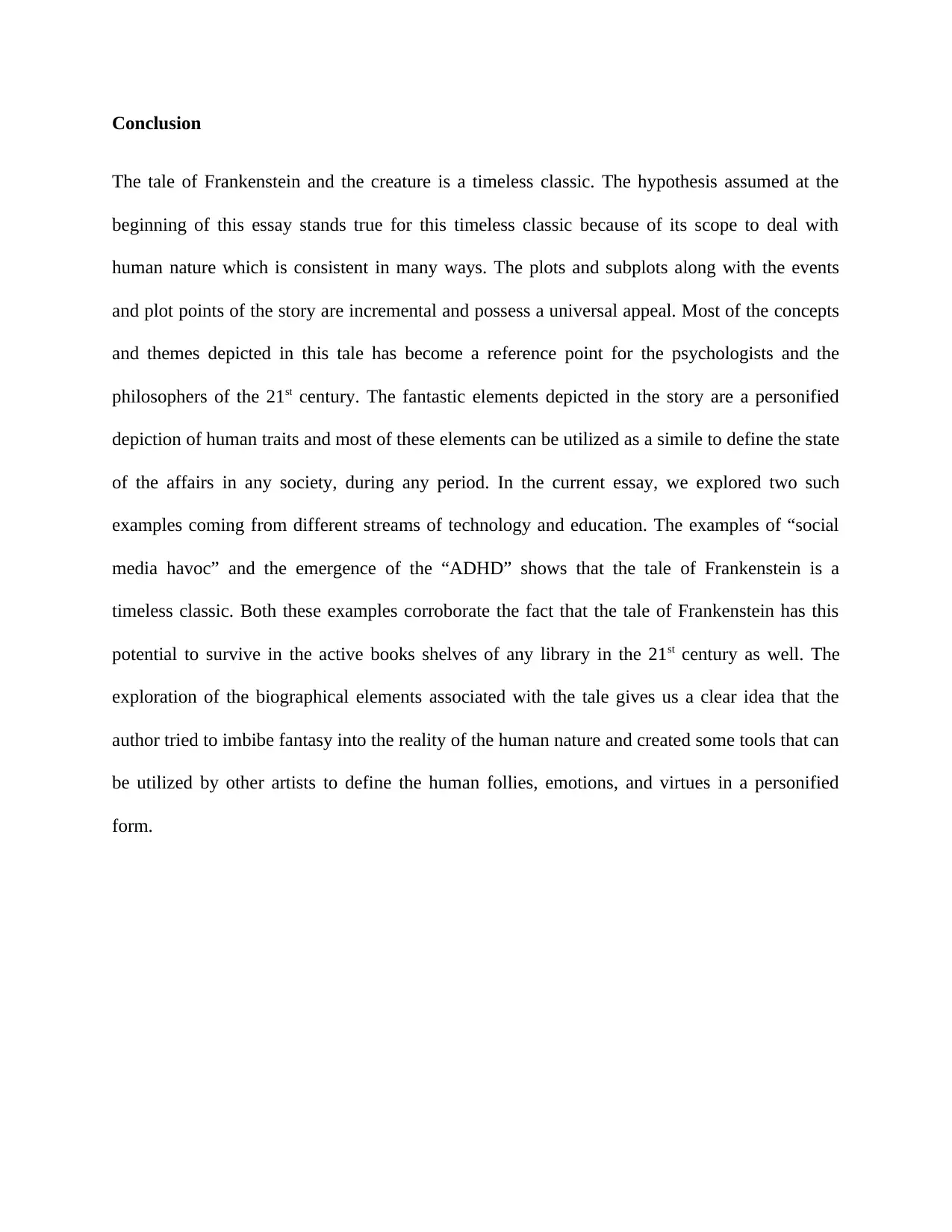
Conclusion
The tale of Frankenstein and the creature is a timeless classic. The hypothesis assumed at the
beginning of this essay stands true for this timeless classic because of its scope to deal with
human nature which is consistent in many ways. The plots and subplots along with the events
and plot points of the story are incremental and possess a universal appeal. Most of the concepts
and themes depicted in this tale has become a reference point for the psychologists and the
philosophers of the 21st century. The fantastic elements depicted in the story are a personified
depiction of human traits and most of these elements can be utilized as a simile to define the state
of the affairs in any society, during any period. In the current essay, we explored two such
examples coming from different streams of technology and education. The examples of “social
media havoc” and the emergence of the “ADHD” shows that the tale of Frankenstein is a
timeless classic. Both these examples corroborate the fact that the tale of Frankenstein has this
potential to survive in the active books shelves of any library in the 21st century as well. The
exploration of the biographical elements associated with the tale gives us a clear idea that the
author tried to imbibe fantasy into the reality of the human nature and created some tools that can
be utilized by other artists to define the human follies, emotions, and virtues in a personified
form.
The tale of Frankenstein and the creature is a timeless classic. The hypothesis assumed at the
beginning of this essay stands true for this timeless classic because of its scope to deal with
human nature which is consistent in many ways. The plots and subplots along with the events
and plot points of the story are incremental and possess a universal appeal. Most of the concepts
and themes depicted in this tale has become a reference point for the psychologists and the
philosophers of the 21st century. The fantastic elements depicted in the story are a personified
depiction of human traits and most of these elements can be utilized as a simile to define the state
of the affairs in any society, during any period. In the current essay, we explored two such
examples coming from different streams of technology and education. The examples of “social
media havoc” and the emergence of the “ADHD” shows that the tale of Frankenstein is a
timeless classic. Both these examples corroborate the fact that the tale of Frankenstein has this
potential to survive in the active books shelves of any library in the 21st century as well. The
exploration of the biographical elements associated with the tale gives us a clear idea that the
author tried to imbibe fantasy into the reality of the human nature and created some tools that can
be utilized by other artists to define the human follies, emotions, and virtues in a personified
form.
Paraphrase This Document
Need a fresh take? Get an instant paraphrase of this document with our AI Paraphraser
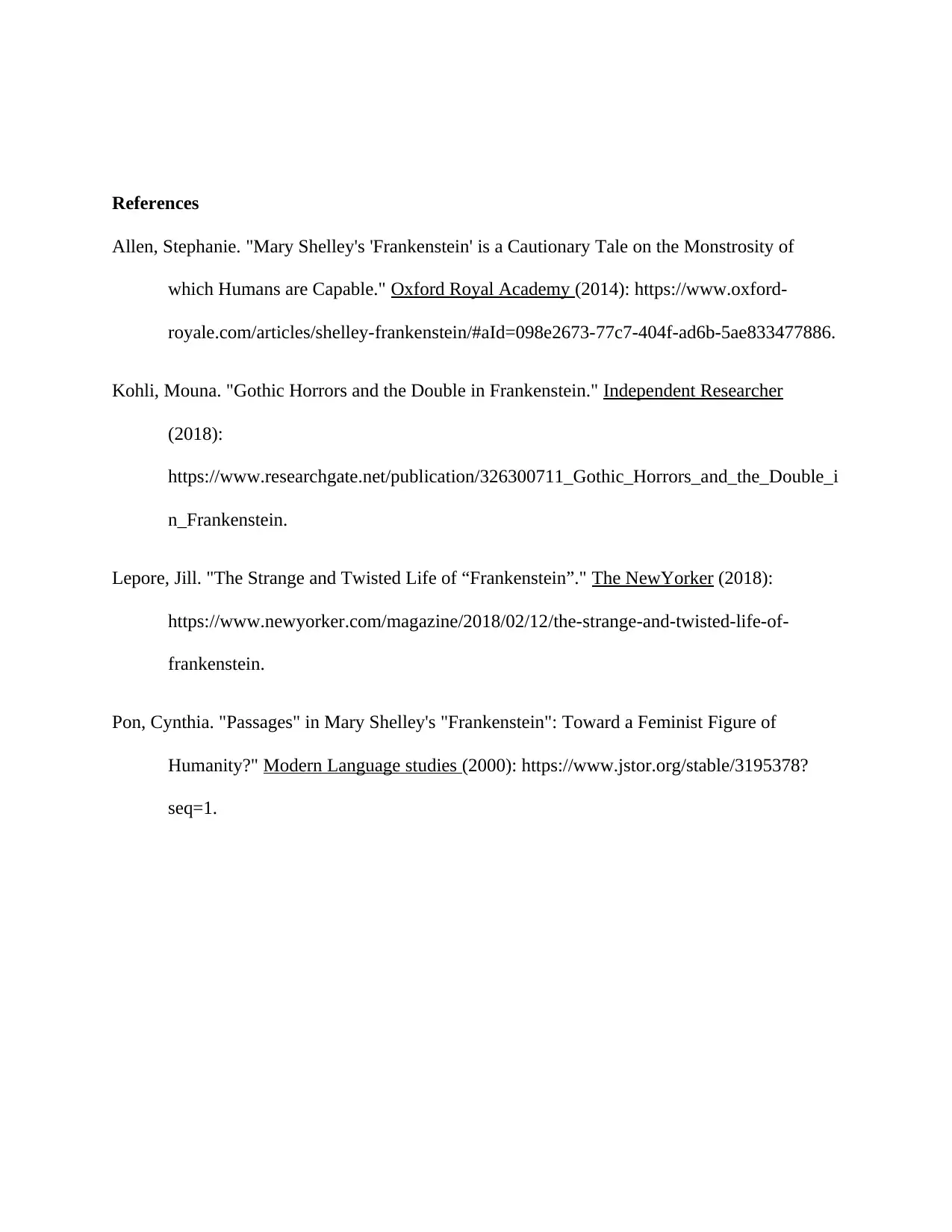
References
Allen, Stephanie. "Mary Shelley's 'Frankenstein' is a Cautionary Tale on the Monstrosity of
which Humans are Capable." Oxford Royal Academy (2014): https://www.oxford-
royale.com/articles/shelley-frankenstein/#aId=098e2673-77c7-404f-ad6b-5ae833477886.
Kohli, Mouna. "Gothic Horrors and the Double in Frankenstein." Independent Researcher
(2018):
https://www.researchgate.net/publication/326300711_Gothic_Horrors_and_the_Double_i
n_Frankenstein.
Lepore, Jill. "The Strange and Twisted Life of “Frankenstein”." The NewYorker (2018):
https://www.newyorker.com/magazine/2018/02/12/the-strange-and-twisted-life-of-
frankenstein.
Pon, Cynthia. "Passages" in Mary Shelley's "Frankenstein": Toward a Feminist Figure of
Humanity?" Modern Language studies (2000): https://www.jstor.org/stable/3195378?
seq=1.
Allen, Stephanie. "Mary Shelley's 'Frankenstein' is a Cautionary Tale on the Monstrosity of
which Humans are Capable." Oxford Royal Academy (2014): https://www.oxford-
royale.com/articles/shelley-frankenstein/#aId=098e2673-77c7-404f-ad6b-5ae833477886.
Kohli, Mouna. "Gothic Horrors and the Double in Frankenstein." Independent Researcher
(2018):
https://www.researchgate.net/publication/326300711_Gothic_Horrors_and_the_Double_i
n_Frankenstein.
Lepore, Jill. "The Strange and Twisted Life of “Frankenstein”." The NewYorker (2018):
https://www.newyorker.com/magazine/2018/02/12/the-strange-and-twisted-life-of-
frankenstein.
Pon, Cynthia. "Passages" in Mary Shelley's "Frankenstein": Toward a Feminist Figure of
Humanity?" Modern Language studies (2000): https://www.jstor.org/stable/3195378?
seq=1.
1 out of 8
Your All-in-One AI-Powered Toolkit for Academic Success.
+13062052269
info@desklib.com
Available 24*7 on WhatsApp / Email
![[object Object]](/_next/static/media/star-bottom.7253800d.svg)
Unlock your academic potential
Copyright © 2020–2025 A2Z Services. All Rights Reserved. Developed and managed by ZUCOL.